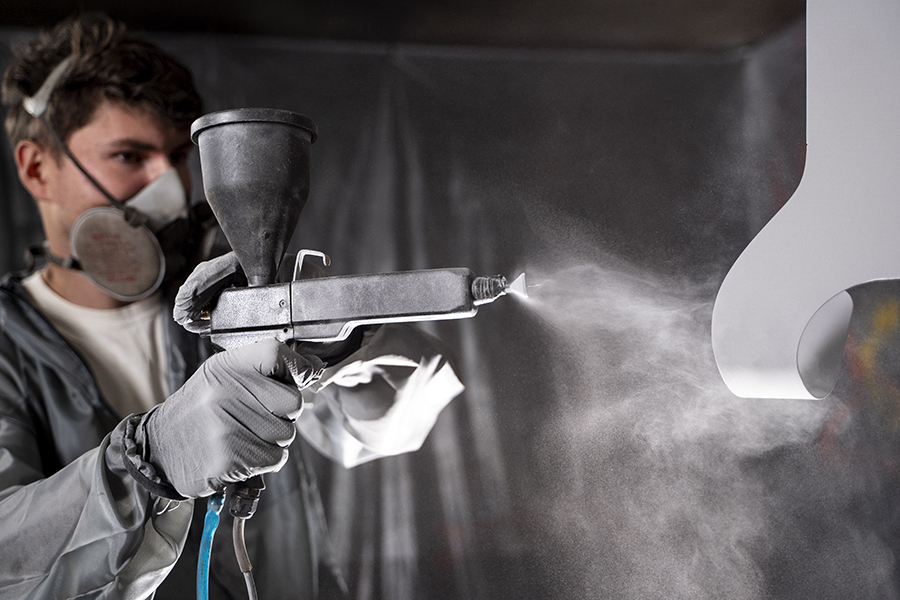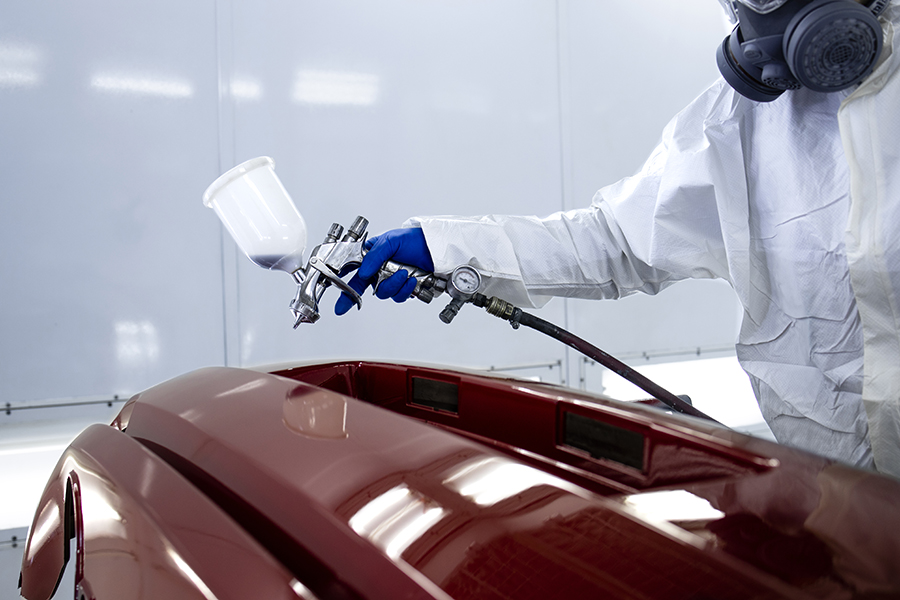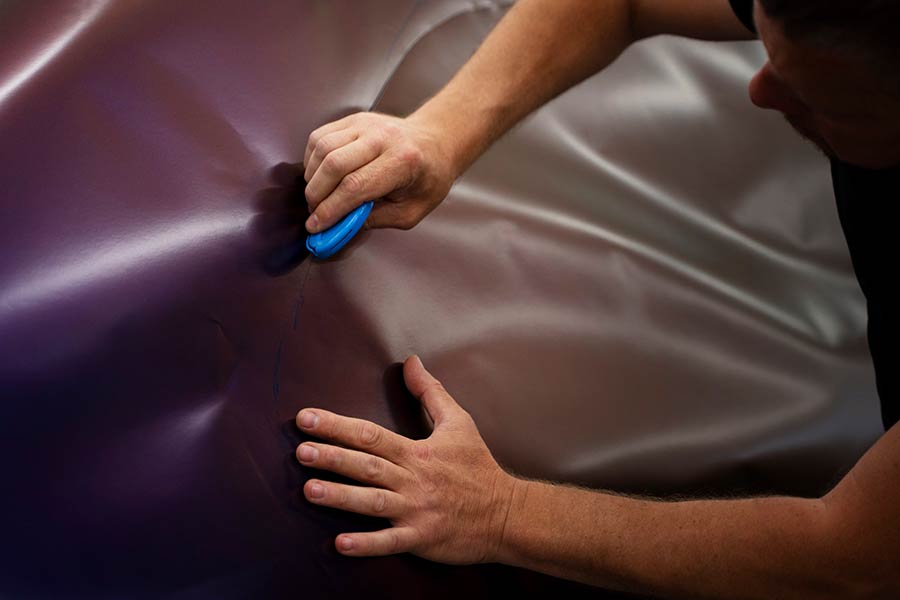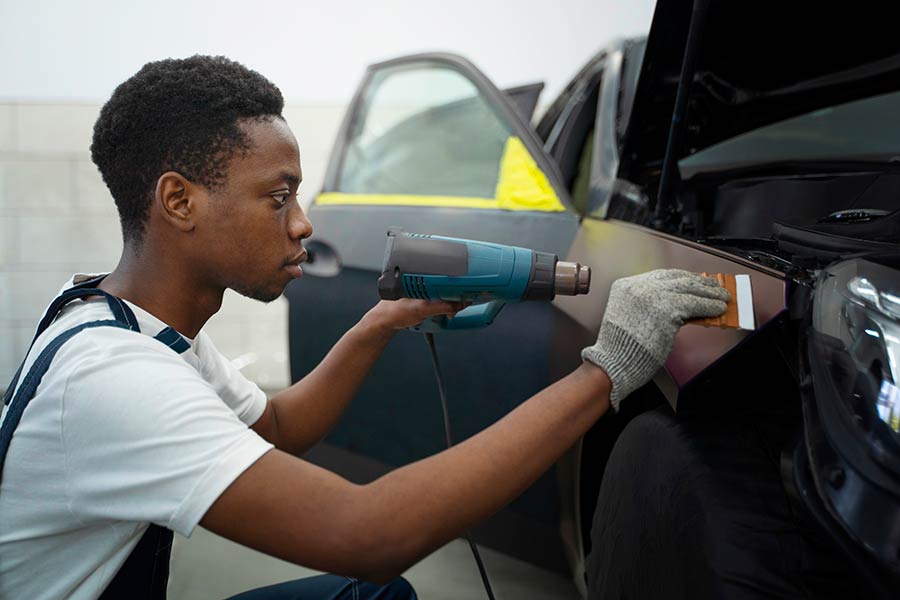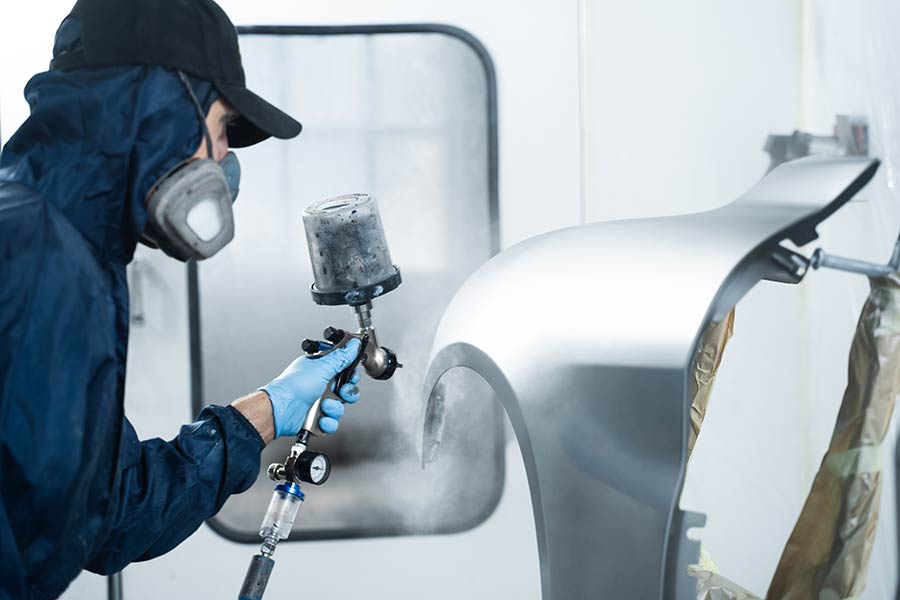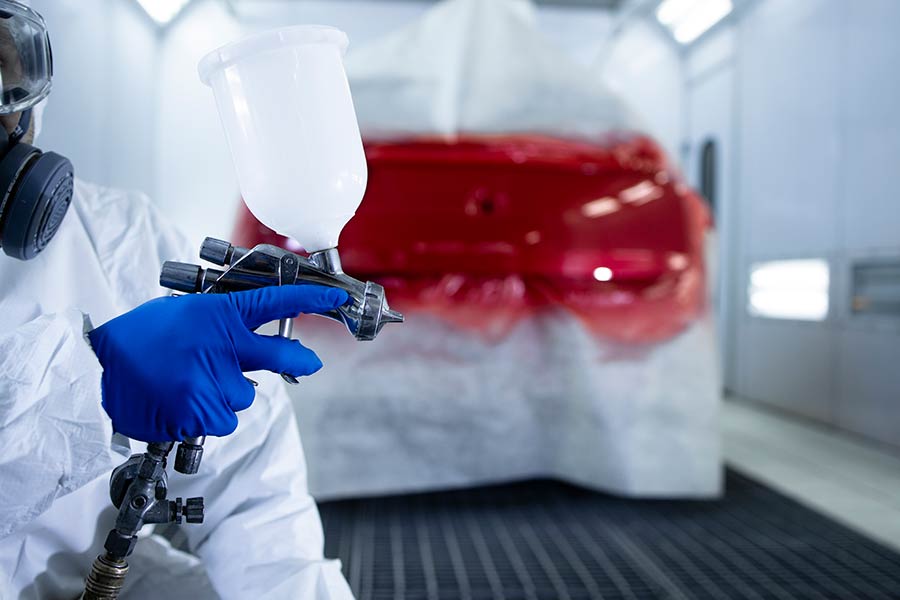Did you know that the average car gets paint damage within the first 5 years of ownership?
From parking lot scratches to weather-related fading, your car’s paint faces countless threats every day. Small chips and scratches might seem minor, but they can lead to rust and bigger problems when left untreated.
As professional auto paint repair specialists, we’ve seen how quick fixes and DIY attempts often make these problems worse. The good news? Most paint damage is fixable when you know the right approach.
In this guide, we’ll walk you through everything you need to know about auto paint repairs, from understanding different types of damage to choosing the best repair methods. Let’s help you keep your car looking its best!
Types of Auto Paint Damage
In my years as an auto paint specialist, I’ve seen countless vehicles with various types of paint damage. Let me break down the three main categories that we commonly deal with in our shop.
Impact and Scratch Damage
The most frequent paint problems I handle come from direct impacts. These range from minor parking lot dings to major collision damage. Here’s what we typically see:
- Deep scratches that cut through to the base coat
- Stone chips from highway driving
- Shopping cart marks and door dings
- Key scratches from vandalism
Environmental and Chemical Damage
Mother Nature can be tough on your car’s paint. I’ve noticed a significant rise in chemical-related paint damage, particularly in urban areas. The main culprits are:
| Damage Source | Impact on Paint |
|---|---|
| Bird droppings | Creates acid etching |
| Tree sap | Forms sticky residue |
| Road salt | Causes paint corrosion |
| Industrial fallout | Leaves metal deposits |
Age-Related Paint Issues
Time takes its toll on every vehicle’s paint. I regularly work with cars showing these aging signs:
The clear coat often weakens first, especially on cars kept outside. This happens more on darker-colored vehicles due to temperature changes. When the clear coat fails, you’ll notice:
- Cloudy or hazy appearance
- Paint peeling in patches
- Oxidation and fading
- Cracking in the paint surface
What makes these issues particularly challenging is their progressive nature. A small chip today can lead to rust tomorrow. That’s why I always tell my clients that early professional assessment makes a big difference in preventing more extensive auto paint repairs down the road.
Professional Paint Repair Methods
Let me walk you through the professional methods we use in our shop for auto paint repairs. As a certified paint specialist with years of experience, I know choosing the right repair method makes all the difference in the final result.
Spot Repair Techniques
For the damage types we discussed earlier, spot repair is often my go-to solution. This method works perfectly for small areas and saves both time and money. I start by carefully cleaning and preparing the damaged area, then apply primer in thin, even layers. The key is keeping the repair area as small as possible while maintaining perfect color match.
Full Panel Respraying
When damage covers more than 25% of a panel, I recommend full panel respraying. Here’s how we compare different repair approaches:
| Repair Method | Best For | Time Required | Cost Factor |
|---|---|---|---|
| Spot Repair | Small damages | 2-4 hours | $ |
| Panel Respray | Large damages | 1-2 days | $$$ |
| Blend Repair | Medium damages | 4-6 hours | $$ |
Paint Matching Technology
The most impressive advancement I’ve seen in auto paint repairs is digital color matching. Using spectrophotometers, we analyze your car’s exact paint color. This technology helps us:
- Create precise color matches for any vehicle make
- Account for paint age and weathering
- Mix paint formulas with computerized accuracy
- Blend new paint seamlessly with existing finish
I always tell my clients that proper paint matching is crucial. Even the smallest variation in color can be noticeable under sunlight. That’s why we invest in advanced digital tools that measure color at a microscopic level.
When working with metallic or pearl finishes, we take extra care during the blending process. These paints require special application techniques to match the original finish’s depth and sparkle. Our digital system stores thousands of paint formulas, letting us recreate even the most complex factory colors.
Paint Quality and Materials
When it comes to paint quality, I’ve learned that choosing the right materials makes all the difference in auto paint repairs. Let me share what I’ve discovered after working with various paint types and technologies.
OEM vs Aftermarket Paint
The choice between OEM and aftermarket paint significantly impacts repair quality. I’ve created this comparison based on my extensive experience:
| Aspect | OEM Paint | Aftermarket Paint |
|---|---|---|
| Quality | Exact vehicle match | Variable quality |
| Cost | Higher investment | More affordable |
| Durability | Superior rust protection | Limited protection |
| Application | Precise fit | May need modifications |
| Safety | ADAS compatible | Potential interference |
Single Stage vs Base/Clear Coat
I’ve worked with both systems, and each has its place. Single stage paint offers a simpler application process and works well for solid colors. However, I recommend base/clear coat systems for most modern repairs because they provide:
- Better UV protection through specialized clear coating
- Superior depth and gloss retention
- Improved resistance to environmental damage
- Easier repair of surface scratches
Modern Paint Technologies
The paint industry has changed dramatically, and I’m excited about the latest developments. Today’s automotive paints feature:
- Water-based formulations that reduce environmental impact
- Advanced polymers for self-healing capabilities
- Nano-technology that improves scratch resistance
- UV-resistant compounds that maintain color vibrancy
I’ve noticed that modern paint systems last significantly longer than their predecessors. The latest water-based paints I use offer excellent coverage while being environmentally responsible. These advanced formulations also provide better adhesion and durability.
What impresses me most about current paint technology is the precision in application. Using electrostatic processes, I can achieve uniform coverage with less waste. The paint’s durability has improved too - I’ve seen modern finishes maintain their glossy appearance for years, even under harsh conditions.
Paint Repair Costs Breakdown
As someone who handles auto paint repairs daily, I want to be upfront about costs. Let’s break down exactly what you’ll pay and why these prices make sense for quality work.
Minor vs Major Repairs
The price difference between minor and major paint repairs can be substantial. Here’s what I typically see in my shop:
| Repair Type | Price Range | What’s Included |
|---|---|---|
| Basic Touch-ups | $300-$1,000 | Single coat, minimal prep |
| Mid-grade Repairs | $1,000-$4,500 | Better prep, multiple coats |
| Premium Work | $5,000-$20,000 | Full sanding, premium paint |
Labor and Material Expenses
I’ve watched paint and material costs rise significantly. Last year alone, labor rates went up by 7.4%. When I calculate costs for my clients, I factor in:
- Paint materials (7% of total repair cost)
- Labor hours (varies by damage extent)
- Prep work and finishing
- Equipment and technology usage
The quality of materials we discussed earlier plays a big role here. Premium paints cost more, but they last longer and match better. I always tell my clients that saving money on materials often leads to higher costs down the road.
Insurance Coverage Factors
Working with insurance companies, I’ve learned what they will and won’t cover. Here’s what you need to know:
- Collision coverage pays for accident-related paint damage
- Comprehensive coverage handles environmental damage
- Your deductible must be met before coverage kicks in
- Minor scratches might fall below your deductible amount
I often see deductibles ranging from $500 to $2,000. When damage costs just slightly more than your deductible, I recommend weighing the benefits of filing a claim against potential premium increases.
Paint repair prices have increased due to new technology and rising material costs. While this might seem expensive, remember that proper paint work protects your car’s value. I’ve seen too many cases where cheap repairs led to rust and bigger problems later.
Common Paint Repair Mistakes
Throughout my career in auto paint repairs, I’ve watched countless DIY attempts go wrong. Let me share the most serious mistakes I see and how you can avoid them.
DIY Repair Pitfalls
My experience shows that DIY repairs often cost more in the long run. Here’s what typically goes wrong:
| Common Mistake | Impact | Professional Solution |
|---|---|---|
| Wrong paint type | Color mismatch | Digital color matching |
| Incorrect tools | Uneven finish | Professional equipment |
| Rush job | Poor results | Proper time management |
Poor Surface Preparation
I can’t stress this enough - surface preparation makes or breaks a paint job. My team spends 60% of repair time on preparation alone. The biggest problems I see are:
- Using household cleaners instead of proper degreasers
- Skipping the sanding step or using wrong-grit sandpaper
- Not removing all rust or old paint before starting
Warning: Paint won’t stick to contaminated surfaces, no matter how expensive it is. I’ve seen $500 worth of premium paint fail because someone skipped a $20 cleaning step.
Incorrect Paint Application
Temperature and timing matter more than most people think. In my shop, I’ve fixed countless paint jobs that went wrong because of poor application. The main issues include:
-
Spraying in extreme temperatures * Too hot: Paint dries too fast and bubbles * Too cold: Paint doesn’t cure properly
-
Wrong paint mixing ratios * Too thick: Creates runs and sags * Too thin: Poor coverage and adhesion
-
Incorrect spray technique * Wrong distance: Causes orange peel texture * Uneven movement: Creates patchy coverage
I recently worked on a car where the owner tried painting in 90-degree weather. The paint dried before it could level out, leaving a rough, bumpy surface. The fix cost three times more than if they’d come to me first.
My professional paint booth maintains perfect temperature and humidity levels. That’s why shop-done paint jobs last years longer than DIY attempts. When you factor in redoing failed DIY work, professional auto paint repairs actually save money.
Conclusion
Professional auto paint repair requires expert knowledge, proper equipment, and careful attention to detail. My years of experience have shown that quick fixes often lead to bigger problems, while professional repairs protect your car’s value and appearance for years.
Paint damage happens to every vehicle, but the right repair approach makes all the difference. Quality materials, precise color matching, and proper application techniques create results that last. Many car owners come to my shop after DIY attempts fail, spending more than if they had chosen professional service initially.
Small paint problems can grow into serious issues when ignored. Rather than risk costly repairs later, I recommend getting expert help early. My team uses advanced technology and proven techniques to restore your car’s finish properly the first time. Ready to fix your car’s paint damage? Schedule repair with our certified technicians today.
## FAQs
-
How much does it typically cost to repair car paint? The cost of car paint repair varies widely depending on the extent of damage. Minor touch-ups can range from $300 to $1,000, while mid-grade repairs might cost between $1,000 and $4,500. Premium work for extensive damage can run from $5,000 to $20,000. Factors affecting the cost include the type of paint used, labor hours, preparation work, and the technology required for the repair.
-
What are the most common types of auto paint damage? The most common types of auto paint damage fall into three categories: impact and scratch damage (such as deep scratches, stone chips, and door dings), environmental and chemical damage (from bird droppings, tree sap, road salt, and industrial fallout), and age-related paint issues (like clear coat failure, paint peeling, oxidation, and cracking).
-
Is it better to use OEM or aftermarket paint for repairs? OEM paint provides an exact match to your vehicle’s original color and offers superior quality and durability. However, it’s more expensive. Aftermarket paint is more affordable but may vary in quality and might require modifications to achieve a proper match. The choice depends on your budget and desired outcome, but OEM paint generally provides better results and long-term protection.
-
Can I repair my car’s paint damage myself? While DIY repairs are possible for very minor issues, they often lead to poor results and can end up costing more in the long run. Professional repairs are recommended because they involve precise color matching, proper surface preparation, and correct application techniques. DIY attempts frequently result in color mismatches, uneven finishes, and inadequate protection against future damage.
-
How long does a professional paint repair typically take? The time required for a paint repair depends on the extent of the damage and the repair method used. Spot repairs for small damages can take 2-4 hours, while full panel respraying might require 1-2 days. Blend repairs for medium-sized damages usually take 4-6 hours. These timeframes allow for proper preparation, application, and curing of the paint.
-
What factors affect the durability of a paint repair? Several factors influence the longevity of a paint repair, including the quality of materials used, the expertise of the technician, proper surface preparation, correct paint application, and the use of modern paint technologies. Professional repairs using high-quality paints, advanced application techniques, and proper curing conditions typically last much longer than DIY or low-quality repairs.
-
How do insurance companies handle paint repair claims? Insurance coverage for paint repairs depends on your policy type. Collision coverage typically pays for accident-related paint damage, while comprehensive coverage handles environmental damage. You’ll need to meet your deductible before coverage applies. Minor scratches might fall below your deductible amount. It’s important to consider potential premium increases when deciding whether to file a claim for paint damage.
-
What are the latest advancements in auto paint technology? Modern auto paint technologies include water-based formulations for reduced environmental impact, advanced polymers with self-healing capabilities, nano-technology for improved scratch resistance, and UV-resistant compounds to maintain color vibrancy. These new paint systems offer better durability, easier application, and longer-lasting finishes compared to older paint technologies.
